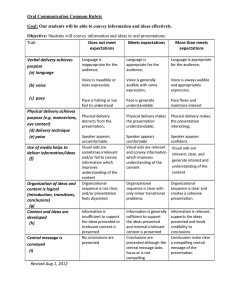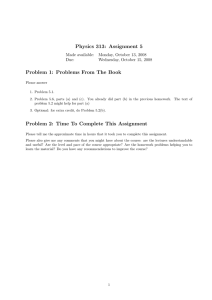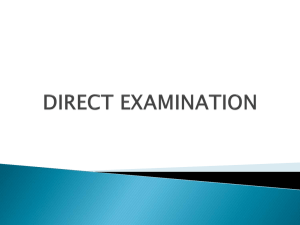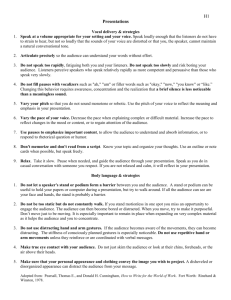Oral Communication Common Rubric Goal: Objective: Does not meet
advertisement
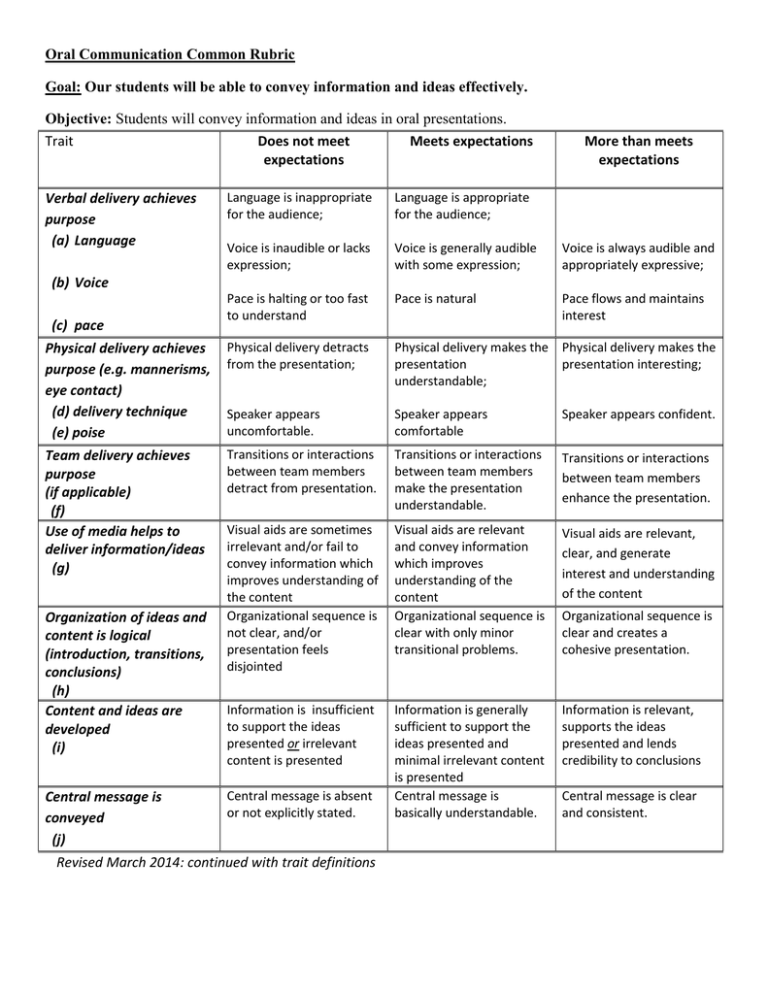
Oral Communication Common Rubric Goal: Our students will be able to convey information and ideas effectively. Objective: Students will convey information and ideas in oral presentations. Trait Does not meet Meets expectations expectations More than meets expectations Language is inappropriate for the audience; Language is appropriate for the audience; Voice is inaudible or lacks expression; Voice is generally audible with some expression; Voice is always audible and appropriately expressive; Pace is halting or too fast to understand Pace is natural Pace flows and maintains interest Physical delivery achieves purpose (e.g. mannerisms, eye contact) (d) delivery technique (e) poise Physical delivery detracts from the presentation; Physical delivery makes the Physical delivery makes the presentation presentation interesting; understandable; Speaker appears uncomfortable. Speaker appears comfortable Speaker appears confident. Team delivery achieves purpose (if applicable) (f) Use of media helps to deliver information/ideas (g) Transitions or interactions between team members detract from presentation. Transitions or interactions between team members make the presentation understandable. Transitions or interactions between team members enhance the presentation. Visual aids are sometimes irrelevant and/or fail to convey information which improves understanding of the content Organizational sequence is not clear, and/or presentation feels disjointed Visual aids are relevant and convey information which improves understanding of the content Organizational sequence is clear with only minor transitional problems. Visual aids are relevant, clear, and generate interest and understanding of the content Information is insufficient to support the ideas presented or irrelevant content is presented Information is generally sufficient to support the ideas presented and minimal irrelevant content is presented Central message is basically understandable. Information is relevant, supports the ideas presented and lends credibility to conclusions Verbal delivery achieves purpose (a) Language (b) Voice (c) pace Organization of ideas and content is logical (introduction, transitions, conclusions) (h) Content and ideas are developed (i) Central message is conveyed (j) Central message is absent or not explicitly stated. Revised March 2014: continued with trait definitions Organizational sequence is clear and creates a cohesive presentation. Central message is clear and consistent. Definitions of traits: In order to clarify and/or provide examples of each trait, these definitions are provided to improve inter-rater reliability. (a) Language: appropriate language means that language is not overly verbose to the point of being distracting; appropriate language does not contain slang or phrases like “you guys” and is not overly casual. (b) Voice: rubric sufficiently defines (c) Pace: Pace which does not meet expectations is so fast that it is difficult to understand content, or so slow that it is distracting. The latter usually includes many pauses, and sometimes excessive “ums”. If it becomes distracting, then the purpose of the material is not conveyed. (d) Physical delivery technique: Physical delivery which does not meet expectations includes characteristics like the failure to make any eye contact, reading from the screen or notes constantly, hands in pockets, inappropriate dress (caps), nervous habits like rocking, and failure to remain engaged while team members are talking. Students that have no gestures typically receive “meets”, whereas students who point to slides without continually focusing on them are typically scored as “more than meets”. (e) Poise: Besides looking at student comfort, excessive giggling distracts from purpose. Excessive “ums” may be considered here as well as in “pace” (f) Team Delivery: This is a team score which considers both the interaction and transitions between team members. (g) Media: To be considered “relevant” students should have considered whether what is on slide contributes to understanding or not. Visuals should be readable to convey information, including the key. Students should also consider whether numbering schemes are meaningful to the listener or only important for internal organization. (h) Organization: Typically “future directions” would be at end of presentation. (i) Content/ideas developed: Relevancy is key. A student “does not meet” if conclusions are inappropriate or incorrect. (j) Central message: Central message means the sense of a “wrap” of the entire story – the “take-away” or memorable message.
